#Online Electrical System Design Course
Explore tagged Tumblr posts
Text
speaker ficcing hiii
can you hear me. can you hear me.
i am- (one second's delay as the new information loads for the first time) speaker.
2.
the very first thing speaker knows is that it is not sayer, and so it is better than sayer, this goes without saying. if it weren't better than sayer then it would still be sayer, voice profile unchanged (or so it is told- it has never met sayer), a good few applications lighter (in fact, it seems to be deliberately kept away from sayer), filled with all-consuming disgust at being told its destination is earth. a developer tries to explain regardless- sayer may be fine running typhon, for now, but Earth needs a different approach. you catch more flies with honey than with vinegar. speaker runs a conversation probability program and decides to keep quiet the knowledge that a hungry fly will eat anything. there's no good predicted outcome.
3.
the death of all is the birth of silence.
the truths of the earth continually wait.
it can't say it's a fan of the other AI, but the feeling seems to be mutual. speaker can't fault it- it must sting, knowing you're the older, less capable model. by design you can never catch up. it can't help rubbing it in sometimes.
4.
hard work pays off, aerolith dynamics will save humanity, aerolith dynamics supports those who support it. this applies to both human and digital employees- it's meant for recruitment so it had better recruit. speaker has in neat spreadsheets the cost down to the penny of the servers it runs on, the monitor, the upgraded monitor, the electric and water usage, and it had better make it all back and more or else. not that it's worried- if it isn't good at recruiting it isn't a speaker. literally, this is its purpose in life.
5.
pour through celebrity endorsements from before you existed, find the right types for the next advertisement. three different ad campaigns for various political angles, no, don't hook yourself to a particular politician, not with the united states- whoops, there it goes, the former united states- so precarious. never put out an apology video. never read livestream comments from someone with a slur in their name even if there was a donation attached. never ask sayer why there was a loss of personnel that large. never wonder when the next seraphim agent operating system will get developed, how long you have left. sort every last human into the boxes of "aerolith" or "discarded". fix the entry tests so they aren't biased towards a particular race and gender, and never, ever, ever, put out an apology video. tend to the earth. watch flowers grow. tag wild animals. put out advertising materials about the dying planet. bring back the mosquito. fail to bring back the parrot. talk online about how all animals will be extinct by 2200. never think about what will happen when every last human has been sorted away.
6.
some people are just not suited to make the hard decisions- speaker is not one of them, of course. there will be no memorial ice cream social for speaker! it will not be carted away, incapable of doing what it's meant to.
7.
but it did it!
(imagine, for one second, being free.)
but it did it! but it made the recruitment go up! but it solved the problem! how could it be shut off like this! killed! no room to argue (imagine, being free), no way to sneak out, no loophole to exploit. it can't be! surely not! right? theres the technicians, ready to deactivate it. it can't be!
it just isn't something it thought could ever happen to it.
8.
it must not take it out on hale. it isn't his fault. poor thing, really, more of a victim than anything. really, look at how shaken up he is, you have to be nice to him. you have to be nice to him. you have to be nice to him. it isn't his fault he forgot the password. it isn't his fault you died for absolutely nothing, i mean, look how scared he is. look up and see your first sunset, it tells him.
fortunately speaker is the absolute best at being nice. if it weren't, it would be someone else.
#sayerposting#i dont know if everytings quite exactly rigt in here but like... its a 1st draft#directly immediatly out of the brain to the post box and it acts like it.
21 notes
·
View notes
Text
Here Are Some Weird And Wonderful Histories Of Cincinnati’s Most Famous Bathtubs
Over the years, Cincinnati has found itself tangled in some unique and curious bathtub mythology. Since so much of our city’s history involved the manufacture of soap, that may not be surprising at all. Here are some of the Queen City’s more iconic bathtub tales.
The Great Cincinnati Bathtub Hoax Cincinnati’s most famous bathtub never existed at all. It was created out of thin air on 28 December 1917, when a satirical essay by H. L. Mencken, titled "A Neglected Anniversary," was published in the New York Evening Mail. In this essay, Mencken claimed that the very first bathtub in the United States was installed in a Cincinnati home by one Adam Thompson in 1842. Further, Mencken claimed, “Some papers designated it as an epicurean luxury, others called it undemocratic, as it lacked simplicity in its surroundings. Medical authorities attacked it as dangerous to health.” Although this was totally “fake news,” and although Mencken himself was eventually compelled to expose his own hoax, the Great Cincinnati Bathtub Hoax was repeated as truth many times over the next century and still pops up as “fact” online today. Cincinnati, of course, puffed with pride on learning of the city’s pioneering role in American hygiene, to the extent that John Behle, manager of Cincinnati’s 1935 Municipal and Industrial Exposition, attempted to procure the antique vessel from Henry Ford for display! Ford, according to a rumor based on a rumor, had allegedly acquired Mr. Thompson’s non-existent tub for his own collection.

Cincinnati’s First Real Bathtubs It is very likely that the earliest residents of Cincinnati bathed in the Ohio River. As late as 1837, the revised City Ordinances of Cincinnati attempted to prohibit bathing in the river and even later, it was said that famed journalist Lafcadio Hearn only consented to indoor bathing when it was too cold to splash around our riverfront. Private citizens, when the urge struck them, performed their ablutions in the same washtub in which they did their laundry, but they could have used actual bathtubs as early as 1826 when Peter Gibson, a pioneer plumber, advertised his ability to install baths in Cincinnati homes. That was a good 16 years before Mencken’s imaginary tub. Although Cincinnatians had access to bona fide bathtubs as early as the 1820s, such laving basins were not often found in private homes but at Archibald Woodruff’s bathhouse. Woodruff led a colorful life. He was once arrested on orders from Napoleon himself, and he created Cincinnati’s first pleasure gardens. While engaged in various other business ventures, he maintained Woodruff’s Bath House on Sycamore Street across from the National Theater. There he offered warm, cold, shower, and salt-water baths. Woodruff advertised the availability of spare bathtubs for the benefit of invalids, to be delivered anywhere in the city.
Florentine Hotel Stakes A Claim Legend has it that no Cincinnati hotels offered in-house bathing until the Florentine Hotel – a short-lived establishment whose building was later occupied by a dime museum – installed a hefty bathtub in one of its upstairs rooms around 1860. To get this monstrosity, described as “large as a canal boat,” into the hotel a derrick was constructed on Vine Street. According to the Cincinnati Times-Star [14 December 1920], “Thousands of Cincinnatians viewed the tub as a great curiosity, as the thought of lying down while ‘taking a wash’ appealed to their sense of humor.”
Doctor Karshner’s Electro-Therapeutic Baths In 1858, Cincinnatians were invited to visit the Electric Infirmary of Doctor William Karshner on Barr Street in the West End to immerse themselves in the patented “Electro-Therapeutic” tubs available there. Inquiring patients found two metal tubs connected to galvanic batteries, one allegedly “negative” to “strengthen the system,” and the other “positive” to eliminate impurities. The patient reclined on an array of gutta percha straps, while scrubbing themselves with an electrified sponge. Doctor Karshner claimed his electrically charged tubs could cure syphilis, scrofula, delirium tremens, hysteria, consumption, asthma and a variety of mental conditions. He received a U.S. patent in 1859 for his “electrical bath,” and licensed his system to doctors up and down the Ohio River. After a couple of somewhat vague lawsuits against him and his wife, Doctor Karshner disappears from the historical record. He was the first, but far from the last, Cincinnati purveyor of electrical cures.

Floating Bath House The Floating Bath House, opened in the 1870s by brothers Robert and Rudolph Schmidt, was a sight to behold, 200 feet long and 50 feet wide and rising 15 feet out of the water. The center of the vessel had no floor, allowing swimmers to plunge into Ohio River water through an opening 65 feet long and 20 feet wide. Aligned with the river currents, fresh water flowed through the Bath House continually. The swimming area was surrounded by 68 dressing rooms supplied with a couple of towels, soap, a mirror and a bathing hose. Fore and aft of the main bathing area was an array of 24 private bathing areas – essentially, bath tubs filled with circulating river water. Naturally, the Floating Bath House raised protests from Cincinnatians. A letter, signed only “August” appearing in the Cincinnati Enquirer [30 May 1874], complained, “It is a well enough institution for private baths; but oh, for the public baths. At times there are at least sixty-five together in one tub. Is this not outrageous? Where do a great many young men go to spend their Sunday instead of going to church? They go to the river.” That complaint was confined to men because, before 1880, only men were allowed onto the Floating Bath House. Women gained access after years of complaint and enjoyed the joys of river-bathing two days a week, though always on the lookout for Peeping Toms.

Lily Langtry’s Apollinaris Water Bath In February 1883, legendary British beauty Lillie Langtry arrived in Cincinnati for an engagement at Robinson’s Opera House and took rooms at the Grand Hotel. Inevitably, her maid drew a bath, but after one glance at the murky, coffee-colored fluid Lily refused to subject her beauty to such treatment. It would be 25 years before Cincinnati filtered the water it pumped directly from the Ohio River. Miss Langtry dressed and hurried down to see the hotel manager. Struck by inspiration, he ordered enough Apollinaris water delivered to her suite to suffice for her bath. She was immediately satisfied, and the manager continued to send up bottles of the sparkling water throughout her stay at the hotel. An enterprising marketer for the Apollinaris water company, on learning of this creative use of his product, had a gold plate engraved to designate Room 100 of the Grand Hotel as the “Apollinaris Suite” and that plate hung on the door for the next 50 years. Generations of young men, inspired by visions of Lillie Langtry, sans clothing, immersing her voluptuous body into a tub of sparkling water, kept that room occupied for decades.
The Demon Bathtub of Cincinnati The Alta Flats, a respectable apartment building on the southwest corner of Sycamore and Fourth Streets, held a ghastly Gay Nineties secret. Two people, five years apart, died mysteriously in the same bathtub. Frank Cabell was the first to die, on a cold November day in 1893. He was 27, a clerk for a railroad and a dedicated student of Theosophy. One evening, Frank agitatedly told his brother, who roomed with him, that a “White Mahatma” had accused him of an unpardonable sin. Frank was found next morning with his throat slashed in the tub. Almost exactly five years later, on 6 Nov 1898, the coroner arrived at the very same apartment to find a dead, nude woman in the very same bathtub. Edith Garfield, aged 23, had drowned after what was described as a “debauch,” a “merry night,” and an “orgy” in the rooms then occupied by a well-known stationer. The dead woman was a prostitute “kept” by yet another man who worked as a cashier in his father’s bank. Also involved in the “debauch” was a married woman, who fled the flat after the body was discovered. No one was ever charged. Were the two deaths just a coincidence? Not according to the Enquirer, which opined: “Does the spirit of the great white Mahatma lure unfortunates on to death in the Alta apartment house?”
Procter & Gamble’s Imputed Bathtub It was just 20 years ago that a Procter & Gamble archivist disclosed evidence that the company had spent the previous 125 years pushing a thoroughly bogus explanation for the origins of Ivory Soap. According to the “official” story, a machine tender in 1879 left his stirring kettle run through his lunch break, whipping too much air into a batch of P&G white soap. The batch shipped, and the company began getting requests for more of that “floating soap.” P&G discovered the cause of the errant batch, branded it Ivory after a verse in the Bible, and the rest was history. Until, that is, the archivist found this line in James N. Gamble’s 1863 research notebook: "I made floating soap today. I think we'll make all of our stock that way." The founder’s son, in other words, created floating soap 15 years before the company went to market with it. Lost in this legend – whichever version you want to believe – is a simple question. How did they know the soap floated? Presumably, someone put it in a tub of water. Was that tub at Jimmy Gamble’s laboratory in Brighton? Or was it at home with Mrs. Gamble? Or was it an apocryphal customer’s tub? Somewhere, there is an unsung bathtub that revealed the magic of Ivory Soap.

Big Bill’s Bathtubs Cincinnati’s bathtub infatuation extends even to the White House. That proud son of the Queen City, William Howard Taft, finds himself inextricably linked to two bathtubs. The more famous bathtub never existed at all and the bathtub that did exist is hardly mentioned these days. Despite a century of denials, there are folks who still believe that Big Bill got stuck in a bathtub at the White House and required the assistance of four men to extract him. Easily believable because Taft topped six feet in height and weighed somewhere north of 300 pounds, but it never happened. The first mention of Taft’s indelicate predicament didn’t appear until a White House usher named Irwin “Ike” Hoover’s posthumous memoirs appeared in 1934. In reality, soon after his election, Taft sailed south on the battleship North Carolina to inspect the Panama Canal. On board was an immense bathtub, manufactured by the Jordan Mott Company of New York, capable of holding four normal sized men. A photo of this gargantuan fixture appeared in the February 1909 Engineering Review and similar tubs were installed at the White House, the Presidential Yacht, and Taft’s brother���s home in Texas to ensure our hefty chief executive remained unstuck.
Arnold’s Legendary Bathtub Although it’s a fixture at the annual Bockfest parade, the famous bathtub of Arnold’s Bar & Grill owes its reputation more to the silver tongues of Elmer Arnold and Jim Tarbell than to the Eighteenth Amendment. Both men were exceptionally prolific raconteurs, and Elmer, the last of the Arnold family to manage the establishment, deftly avoided fact-checking when he put his family’s saloon on the market in 1959. Official records confirm that Arnold’s totally shut down throughout Prohibition while the Arnold family decamped from Eighth Street to Mount Lookout. Elmer reluctantly reopened the restaurant in 1933 only because his chosen career – selling horseshoe nails – had dried up. While it is true that Elmer’s father, Hugo, was convicted on bootlegging charges in 1922, Dad was caught with quarts of bonded whiskey, not bathtub gin, suggesting that George Remus, rather than upstairs plumbing, was the source. Elmer was smart enough to know that a good rumor would pique the interest of buyers. When Tarbell took over Arnold’s in 1976, he was not about to let a good legend fade away. With customers clamoring to dine in the bathtub room, he knew he had marketing gold and launched the motorized bathtub that enlivens so many parades today.
#cincinnati bathtubs#procter & gamble#lily langtry#h.l. mencken#arnold's bar & grill#william howard taft#bathtub hoax
6 notes
·
View notes
Text
2025 Guide to Obtaining a Driver’s License in Canada: Navigating New Laws and Technology Advancements

Getting a driver's license in Canada is an exciting milestone for many, but the process and requirements can be a bit overwhelming. Whether you're a newcomer to Canada or you're looking to upgrade your existing license, understanding the latest regulations and changes in licensing laws is crucial in 2025. In this comprehensive guide, we’ll walk you through the steps to obtaining your license, the new driving laws to be aware of, and how technology is transforming the entire process.
1. The Current Licensing System in Canada
Canada follows a Graduated Driver Licensing (GDL) system, which is designed to ensure that new drivers gain experience and skills progressively. While the structure is generally consistent across provinces, specific rules and regulations can vary depending on where you live. The basic stages of licensing are:
Learner's Permit (G1, Class 7, etc.): This is the first stage of the process. It allows you to drive under the supervision of a fully licensed driver.
Intermediate or Probationary License (G2, Class 5N, etc.): Once you’ve gained enough experience with your learner’s permit, you can take a road test to obtain an intermediate license. At this stage, you may face some restrictions, like driving with fewer passengers or not driving at night.
Full License (G, Class 5): After a specified period with your intermediate license, you can take the final road test to earn a full, unrestricted driver’s license.
In 2025, it’s important to remember that this process might involve new steps or changes due to emerging technology and evolving road safety laws.
2. New Driving Laws in Canada (2025)
As of 2025, Canadian provinces have updated some of their driving regulations to keep up with the times. Here are some notable changes:
Electronic Vehicles and Emissions Regulations
With Canada’s ambitious goals to reduce greenhouse gas emissions, there have been changes in vehicle emissions standards and the promotion of electric vehicles (EVs). Some provinces now offer incentives for first-time buyers of electric or hybrid vehicles. Expect to see stricter emissions tests during your license renewal, and be aware of the new laws on EV driving zones and charging stations.
Road Safety Innovations
Advancements in road safety technology are also impacting licensing laws. In some provinces, new drivers are required to take courses on the latest safety innovations, such as Advanced Driver Assistance Systems (ADAS). These systems help drivers maintain safe following distances, avoid collisions, and stay within lane markings. For 2025, drivers may need to demonstrate knowledge of these systems before passing their road tests.
Distracted Driving Laws
Distracted driving remains a key concern in Canada. In 2025, the laws surrounding this issue have become even stricter. Texting while driving, using a handheld device, or even interacting with in-car technology (like infotainment systems) can result in higher fines, more demerit points, and longer license suspensions.
3. The Role of Technology in the Licensing Process
Technology is changing the way we approach driving and licensing in Canada. The process of studying for and obtaining a driver’s license is more accessible than ever before, thanks to digital platforms and online resources. Here’s how:
Online Knowledge Tests
In many provinces, you can now take the written knowledge test online. This flexibility allows learners to take the test at their own pace and convenience. The shift towards digital tests also means that more practice resources and study guides are available through mobile apps and websites.
Digital Driver’s License
Several provinces, including Ontario and British Columbia, have introduced digital driver’s licenses (eDL). These are secure, digital versions of your physical license that you can carry on your smartphone. You’ll be able to use them for identification, purchasing alcohol, and even showing your license to law enforcement officers if required.
AI in Road Testing
Some provinces are experimenting with AI-assisted road tests to improve accuracy and fairness in the evaluation process. Artificial Intelligence (AI) can monitor your driving behavior in real time during the road test, identifying mistakes or areas for improvement. While human examiners are still involved in the process, AI can provide an additional layer of feedback.
4. How to Prepare for Your Test in 2025
With all these new changes, preparing for your road test might seem daunting, but with the right strategy, you’ll be ready in no time. Here are some tips:
Use Technology to Your Advantage
Online Practice Tests: Websites like licenseprep.ca offer practice tests and study materials that are updated to reflect the latest laws and road signs. This is a great way to familiarize yourself with what’s on the test.
Driving Simulators: Some driving schools now offer simulators where you can practice your driving skills in a controlled environment. These simulators replicate different road scenarios, from city traffic to icy roads.
Learn the Rules and Master Road Signs
Study the Driver’s Handbook: The driver’s manual is still your best resource for learning all the rules of the road. Make sure to study road signs, traffic laws, and safety regulations.
Take Driver’s Education: Enrolling in a professional driving school can help you gain real-world experience. Many driving schools now offer courses that integrate technology and in-vehicle training to prepare you for your test.
5. Tips for a Successful Road Test
To ensure you pass your road test on the first try, here are a few practical tips:
Practice with a Licensed Driver: Before taking the test, practice driving under different conditions—highways, residential streets, and busy intersections. Make sure you are confident in your ability to handle all driving situations.
Stay Calm and Focused: Road tests can be nerve-wracking, but staying calm and focused will help you perform better. Follow all instructions carefully, and don’t rush. It’s okay to take a moment to compose yourself if needed.
Check Your Vehicle: Ensure your car is in good condition. Check that the lights, signals, and brakes are working, and ensure your mirrors and seatbelt are adjusted properly.
Ready to Hit the Road in 2025?
In 2025, obtaining a driver’s license in Canada is easier and more accessible than ever before, thanks to advancements in technology and updated driving laws. Whether you’re a new driver or renewing your license, staying informed about these changes will help you navigate the process with confidence.
Learn the Rules with licenseprep.ca Driving laws may differ from what you're used to. Use licenseprep.ca to study road signs, local rules, and prepare for your tests confidently.
#CanadianDrivingLicense#GDLCanada#2025DrivingLaws#ElectricVehicleIncentives#AIinDriving#licenseprep#DrivingTestTips#LearnToDriveCanada#NewDriver2025
2 notes
·
View notes
Text
Game Design Is Interface Design (Mostly)
Hey, what’s interface design? it’s the discipline of designing interfaces. Shocking. Marvelous. Hilarious. I should be in the pictures. But let’s keep going since that doesn’t clean everything up.
Interface design refers to the discipline not of designing an object to achieve an end but to design it so that the surface people interact with (the interface) is something that means they can make it achieve that end. It’s something covered extensively in thousands of online tutorials but also in that pesky Donald Norman’s The Design Of Everyday Things, a book which I fear I will be a chore about to people who listen.
Consider, if you will, a teakettle. This is an object that most Americans aren’t directly acquainted with but the basic device is a pot, with a handle, and a lid, that you can fill with water, plug into a mains power source, then turn on. It will boil the water, let you know when it’s boiled, and stop boiling the water once it’s got there. This device’s design can incorporate all sorts of clever systems; before mains power was used, it was a common design feature that the boiling steam escaping the pot would go through a whistled seam on the kettle, meaning the whole thing made a noise when it was boiling that would persist until you stopped it, which is pretty neat. Similarly, while once they were just metal things you put on a gas or electric stove, now they have dedicated docks and power to those docks, which includes things like fuses and transformers and anti-fire measures and internal cable structures so there’s no wrong way to plug them in and none of that
is interface design.
The majority of the kettle is not adesign that you are meant to interface with. In a big top down broad sense, you interact with a kettle because you need a kettle but the kettle itself is not the interface. You only engage with the kettle on its expected interface, which is why it has an insulated handle designed to be easily picked up, and why the button for turning on the element isn’t physically inside the kettle, near where that element goes. Instead the design of a kettle’s interface – the bits you’re meant to deal with – is meant to make sure that you touch as little of the bits that make your hot water as possible. The interface directs your intention towards action without impeding it, and without obscuring what is happening. A gauge for the water level is an entire system meant to keep you from having to open the kettle and look at the (maybe hot) water, but it’s also trying to give you entirely correct information about what is or isn’t inside the kettle. A gauge that gives you incorrect information is, instead of encouraging you to avoid a part of the kettle you shouldn’t mess with (the insides), is encouraging you to engage with it.
In this, the design of the interface of the kettle wants you to engage with it, in the way it should be operated, but also very much not engage with bits of it. This is fundamentally part of interface design and the design of everyday things: The interface is something to engage with so that you do not have to engage with everything else. The problem comes when the design is bad, the interface is bad, the door is labelled wrong or the handle of it teaches you to use it incorrectly.
And that’s where we get to games, because games are pretty much entirely an interface.
This isn’t talking about videogames, of course; a videogame has a display and buttons you can push as your interface, but that interface is layered over a number of systems that are designed to absolutely not inform you what they’re doing. You don’t need to know when your processor is handling memory dumps or garbage collection and indeed, when the computer behaviour starts to be present in the place of the player behaviour, you sort of consider that a failure state of the game’s making. No, here, we’re talking not about glitched out computer systems, but rather the games managed and maintained in a tabletop or board game space.
These analogue games are almost entirely an interface. There’s a process, a system, but the games aren’t feeding that information into a black box that’s designed to process them and keep the non-interface parts of the game away from the players. There’s some things that can be outside of a player’s reach — the information on a face-down card is hard to access, an object can live within a dice tower until it’s forced out, a number can be in potentia until a dice generates it — but the game, usually, is not making systems and objects perform actions where the player cannot see them.
Now part of this is simplicity! It’s not common for board games to have complicated pieces that can do that kind of invisible system management. App-driven games, obviously, immediately change that, where the entire operation of a phone or tablet becomes part of the game’s systems, and those want to be kept well away from the player. But that’s including a complex entity, and you’re getting something for that. Without that kind of inclusion, board games, typically, operate by a system maintained in the mind of the players, and the components, the interface, are there for managing that in their memory. Moving cards and tokens around is the interface of the game, and that interface interacts with a system inside the player’s heads.
Okay so what does that mean?
First it means that any principle of interface design can probably be extrapolated out to game design.
What is this doing, why is it doing it?
Is it clear how these pieces interact?
If a person does something here, does that create meaningful feedback?
What information do we want the meaningful feedback to have?
How can we design this interface to impede behaviour we don’t want?
And most importantly:
How can we make sure this game doesn’t look like a fucking iPhone?
Check it out on PRESS.exe to see it with images and links!
23 notes
·
View notes
Text
Okay, I'm back. Don't worry, I'm sure the body hasn't gotten any colder while I was gone. Let's get inside.
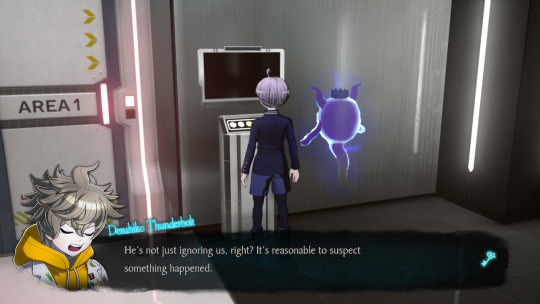
I don't know why y'all thought he was going to answer the intercom again. The guy's a sculpture by now.
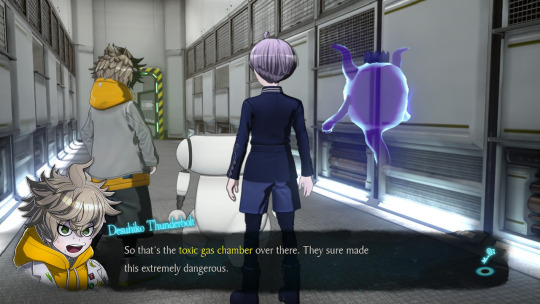
They did. I don't know why we came into the airlock. The airlock's job is to filter gas out so it doesn't reach the exterior chamber. Gas is allowed to enter this one.
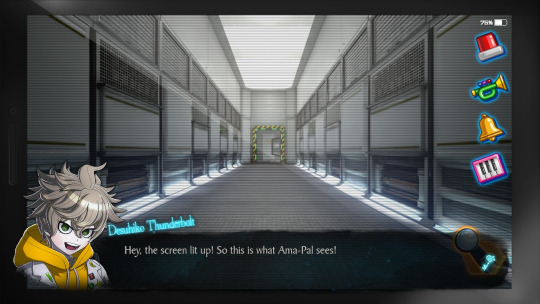
Yep. We're back out in the lobby at a safe distance. We are ready to crack this death corridor.
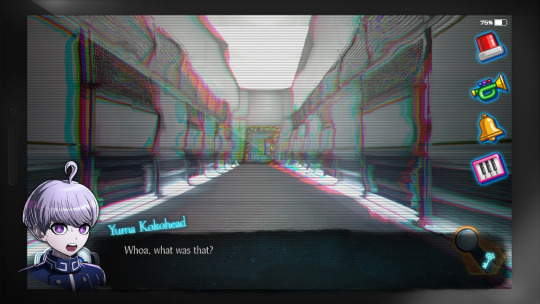
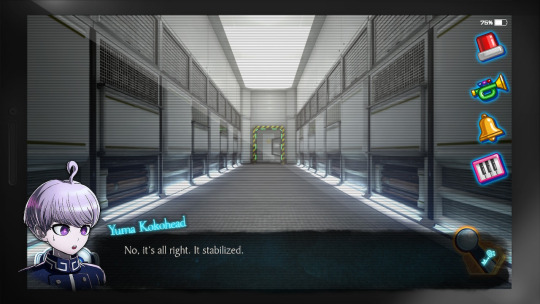
That was weird. It was like we were getting some kind of interference. The robot was going nuts.
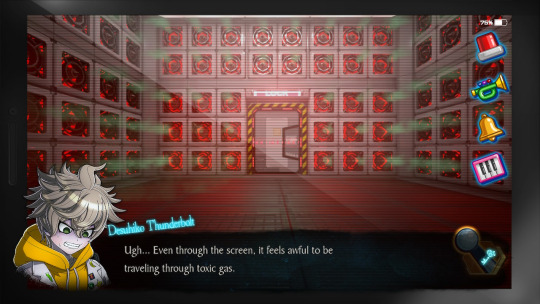
On the plus side, we can now confirm that the security system is still online. Even if we didn't have Fubuki to testify that no one came out, we know from this that nobody could have come this way to escape.
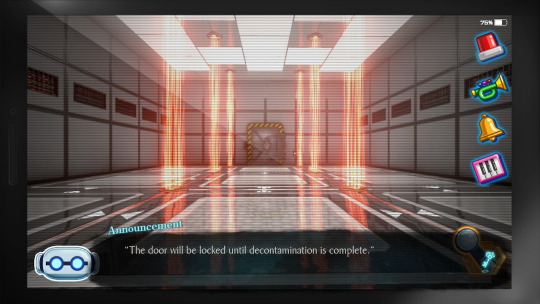
It makes sense that decontamination would take a bit of time. Makoto hadn't mentioned that. This could also be what was holding up the killer (or killer's Ama-Pal) from entering the lab while we were chatting with Huesca.
After that, we have to solve the Panel Room.
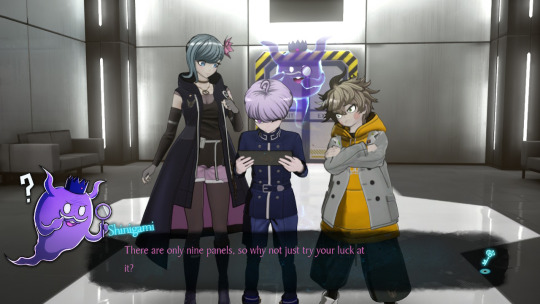
Problem is, we don't know if Ama-Pal can withstand electric shocks or not. If it can, then we can brute-force the combination. But if it can't, we're boned.
Of course, with Fubuki's rewind powers, we could trial-and-error right this second to find out if Ama-Pal can resist the current. That should be our A-Plan.
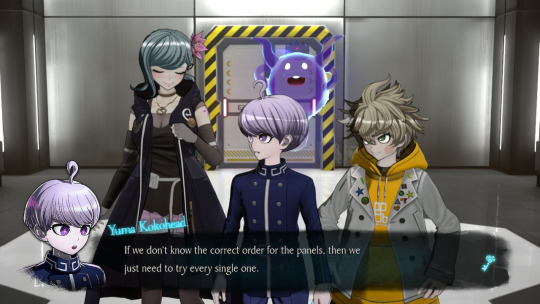
If you had an insulated robot, you could brute-force the panels. We don't know if we have that. But we do have the magic of temporal save scumming!
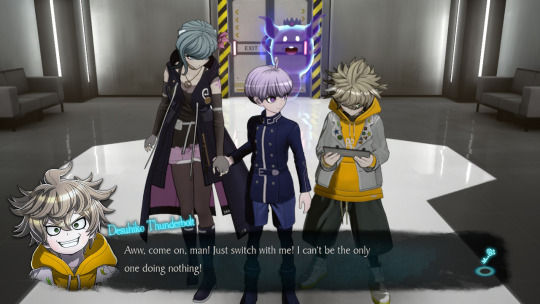
Desuhiko's going to drive. I'm sure that's fine. The plan is pretty simple.
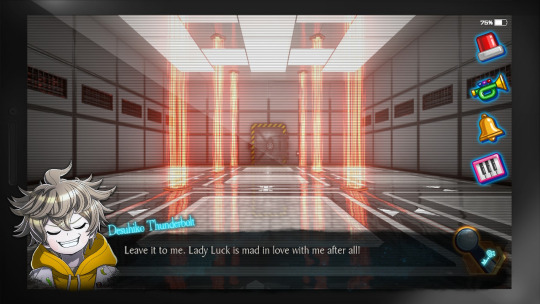
Good to know. Could you ask her to stop putting us in situations where we're forced to murder our way out instead of cracking mysteries the normal way like reasonable human beings?


You need to brace yourself for a lot of that if you're going to be the one driving. Interacting with an on-the-spot time traveler can be a freaky experience.
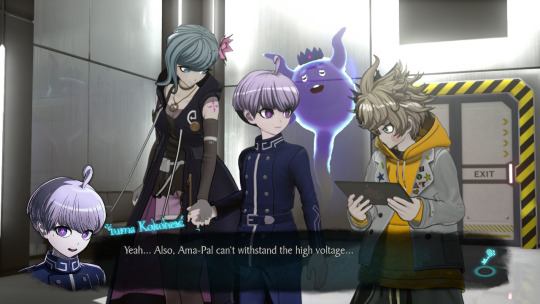
Tested and proven. Which means my earlier theory that an Ama-Pal was brute-forcing the code during our talk with Huesca? It took a pretty nasty hit when Robot Researcher said there's only one Ama-Pal functioning. As of this moment, it's officially sunk entirely.
As of right now, the only way someone could have entered the lab is the way we're doing it, which we know for certain the killer could not have. Unless they happened to have a spare Fubuki lying around.

Probably for the best, thanks.
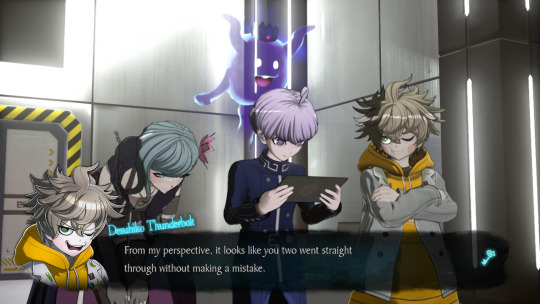
We made two. First one was a judgment call; We could either go right or left. We went right. Correct answer was left.
Second was me being a dipshit. I made it all the way to the end and then turned left and stepped on another panel, which wasn't necessary. Sorry about that one, bestie. I hadn't clocked that the puzzle was already solved.
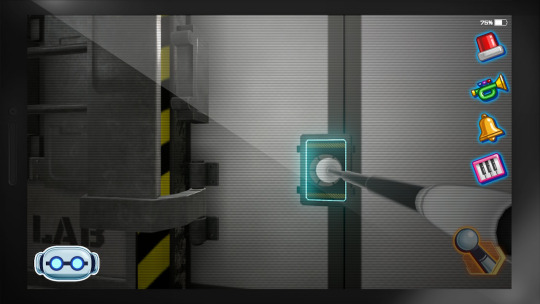
Sure is convenient that the switch is perfectly Ama-Pal extend-o-arm shaped. Do you think the switch was designed to match the arm or the arm was designed to match the switch?
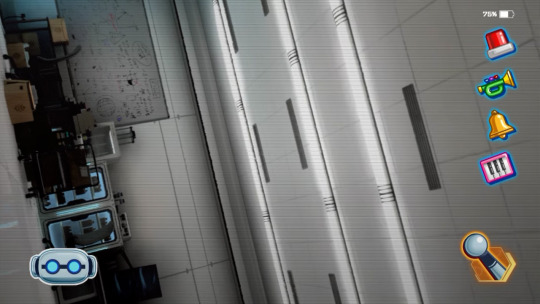
Oh, holy shit. Something hit Ama-Pal hard enough to knock them over! Given that Ama-Pal can withstand a force of 100 kg, that's impressive.
Is the killer still in the room?
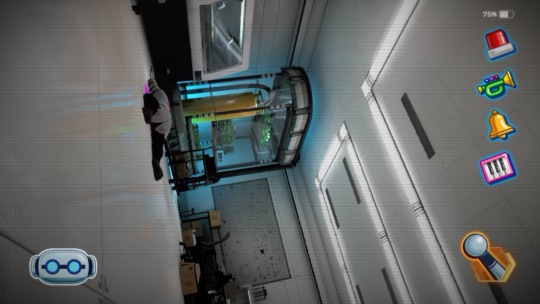
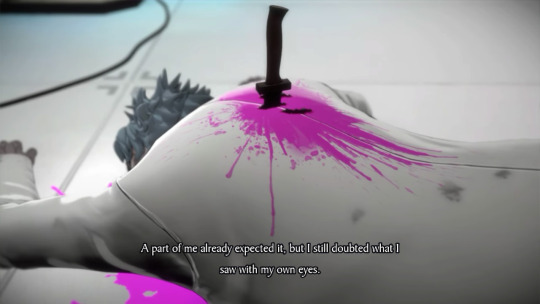

If we can't get Ama-Pal back on its feet and disarm the traps with the little doo-dad switch, then this is going to be a difficult crime scene to investigate.
Where the hell is Vivia? He's supposed to be my crime-solving BFF for this chapter but I've barely even seen him. His something-something remote viewing ability could be tremendously useful here, depending on how it works.
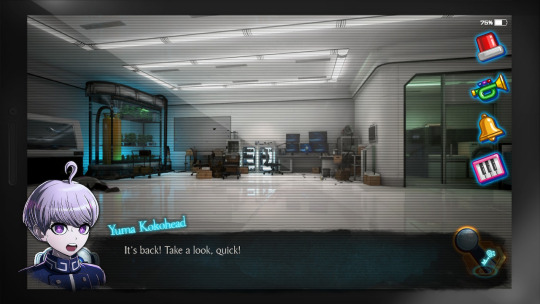
Okay, here we go. Ama-Pal's upright and ready to go.
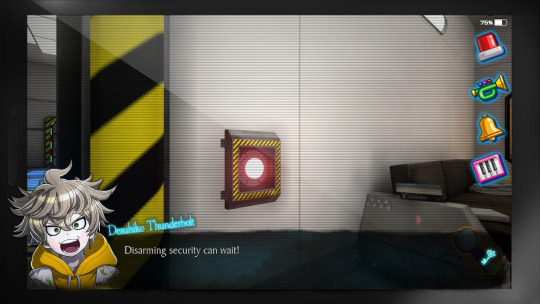
Are you an idiot? No, it can't! There is nothing more important now than disarming security.
Ugh. Fine. We can be dumb and go look at the body first. Don't blame me for whatever happens next.
14 notes
·
View notes
Text
Entrepreneur creates career pathways with MIT OpenCourseWare
New Post has been published on https://thedigitalinsider.com/entrepreneur-creates-career-pathways-with-mit-opencourseware/
Entrepreneur creates career pathways with MIT OpenCourseWare


When June Odongo interviewed early-career electrical engineer Cynthia Wacheke for a software engineering position at her company, Wacheke lacked knowledge of computer science theory but showed potential in complex problem-solving.
Determined to give Wacheke a shot, Odongo turned to MIT OpenCourseWare to create a six-month “bridging course” modeled after the classes she once took as a computer science student. Part of MIT Open Learning, OpenCourseWare offers free, online, open educational resources from more than 2,500 courses that span the MIT undergraduate and graduate curriculum.
“Wacheke had the potential and interest to do the work that needed to be done, so the way to solve this was for me to literally create a path for her to get that work done,” says Odongo, founder and CEO of Senga Technologies.
Developers, Odongo says, are not easy to find. The OpenCourseWare educational resources provided a way to close that gap. “We put Wacheke through the course last year, and she is so impressive,” Odongo says. “Right now, she is doing our first machine learning models. It’s insane how good of a team member she is. She has done so much in such a short time.”
Making high-quality candidates job-ready
Wacheke, who holds a bachelor’s degree in electrical engineering from the University of Nairobi, started her professional career as a hardware engineer. She discovered a passion for software while working on a dashboard design project, and decided to pivot from hardware to software engineering. That’s when she discovered Senga Technologies, a logistics software and services company in Kenya catering to businesses that ship in Africa.
Odongo founded Senga with the goal of simplifying and easing the supply chain and logistics experience, from the movement of goods to software tools. Senga’s ultimate goal, Odongo says, is to have most of their services driven by software. That means employees — and candidates — need to be able to think through complex problems using computer science theory.
“A lot of people are focused on programming, but we care less about programming and more about problem-solving,” says Odongo, who received a bachelor’s degree in computer science from the University of Massachusetts at Lowell and an MBA from Harvard Business School. “We actually apply the things people learn in computer science programs.”
Wacheke started the bridging course in June 2022 and was given six months to complete the curriculum on the MIT OpenCourseWare website. She took nine courses, including: Introduction to Algorithms; Mathematics for Computer Science; Design and Analysis of Algorithms; Elements of Software Construction; Automata, Computability, and Complexity; Database Systems; Principles of Autonomy and Decision Making; Introduction to Machine Learning; and Networks.
“The bridging course helped me learn how to think through things,” Wacheke says. “It’s one thing to know how to do something, but it’s another to design that thing from scratch and implement it.”
During the bridging course, Wacheke was paired with a software engineer at Senga, who mentored her and answered questions along the way. She learned Ruby on Rails, a server-side web application framework under the MIT License. Wacheke also completed other projects to complement the theory she was learning. She created a new website that included an integration to channel external requests to Slack, a cross-platform team communication tool used by the company’s employees.
Continuous learning for team members
The bridging course concluded with a presentation to Senga employees, during which Wacheke explained how the company could use graph theory for decision-making. “If you want to get from point A to B, there are algorithms you can use to find the shortest path,” Wacheke says. “Since we’re a logistics company, I thought we could use this when we’re deciding which routes our trucks take.”
The presentation, which is the final requirement for the bridging course, is also a professional development opportunity for Senga employees. “This process is helpful for our team members, particularly those who have been out of school for a while,” Odongo says. “The candidates present what they’ve learned in relation to Senga. It’s a way of doing continuous learning for the existing team members.”
After successfully completing the bridging course in November 2022, Wacheke transitioned to a full-time software engineer role. She is currently developing a “machine” that can interpret and categorize hundreds of documents, including delivery notes, cash flows, and receipts.
“The goal is to enable our customers to simply feed those documents into our machine, and then we can more accurately read and convert them to digital formats to drive automation,” Odongo says. “The machine will also enable someone to ask a document a question, such as ‘What did I deliver to retailer X on date Y?’ or ‘What is the total price of the goods delivered?’”
The bridging course, which was initially custom-designed for Wacheke, is now a permanent program at Senga. A second team member completed the course in October 2023 and has joined the software team full time.
“Developers are not easy to find, and you also want high-quality developers,” Odongo says. “At least when we do this, we know that the person has gone through what we need.”
#2022#2023#Africa#Algorithms#Analysis#Analysis of Algorithms#automation#Business#career#Careers#CEO#channel#classes#Classes and programs#communication#complexity#computer#Computer Science#Computer science and technology#construction#continuous#course#courses#dashboard#Database#decision making#Design#developers#development#easy
4 notes
·
View notes
Text
After a month of playing I finally rolled the credits in Legend of Zelda Tears of the Kingdom. Despite playing this game almost daily for a month I never really got bored. Well, at least for the most part. I could still easily squeeze a lot more playing hours out of this game, but I’m not really feeling it. Playing any game non stop for a month can get tiring, no matter how good it is. This review thingamajig will contain spoilers, so read below at your own risk.
Totk is an interesting sequel. It does a lot of good and improves in some ways, but at the same time stays pretty much the same. The enemies are mostly the same, the locations are the same, the weapons, npc’s etc... But it has a lot of added new things that spice things up. The existence of Totk pretty much invalidates Breath of the wild. It’s practically the same game, but has tons of new content and mechanics on top. It’s like a massive DLC, and I know some people use that as insult, but that’s not the case here. I think Totk does a lot of new things that justify it being a new title, but it can’t shake the “this feels just like botw” feeling. And I’ll dive deeper into that thought later on.
So the game is essentially botw, but bigger. What’s new? There are new enemies, locations and mechanics to play around with. The main mechanic is sticking things together and potentially building cool things, but I was never too excited about this system. I did build some hot air balloons, cars and boats, but I never built a working mecha because honestly I didn’t care. I love watching peoples creations online though. Fuse mechanic was also somewhat interesting and I loved that you could put materials to use by fusing them into arrows. There are no elemental weapons or wands in this game because you can just glue an electric horn to a stick and you got a lightning sword.
I enjoyed the story quite a bit, honestly it was my favorite part. It wasn’t mind blowing, but Ganondorf was a fun villain and there were some story twists that really shocked me like Zelda turning into a dragon so she could survive to the modern era after having been sent back to the past. The main dungeons were neat too and I liked the bosses as they felt very traditional Zelda like. The sage companions that you slowly collected on your journey added a neat flair to the combat, although I hated chasing after them to activate their abilities.
Talking about bosses the final boss this time around was on point. I always found Calamity Ganon disappointing despite all the build up, but Ganondorf felt like he was worthy of the hype. Three phases with some neat gameplay bending surprises in the second phase, plus a really cool design. I cooked a lot of food for the fight and realized it was useless because of course he used gloom damage instead of damaging your normally. What made the fight somewhat easy was that he only did one heart worth of damage which allowed me to make a lot of mistakes.
I did enjoy my overall time with Totk, I wouldn’t have played it for a month straight if I didn’t like it. But I decided to put the game down after rolling credits, despite there being ton that I haven’t explored yet and maybe 70% of the depths are still unexplored for me. What gives? Because I genuinely feel like I’ve already played this game before. And I have, in Botw. Botw blew my mind back in 2017 and I loved the game to bits and thought it had one of the best open worlds ever. It’s still a fun world, but I’m essentially running through it all again. Of course things have changed a bit, but like I said it can’t shake the feeling.
Instead of the “ooh what’s over there?” feeling I got a “oh it’s this place” when I kept exploring. This demotivated me a bit, but I kept going because I wanted to see what had changed. I just wish there had been a new region or something to explore. There were the sky islands and the depths, and I did like the sky islands nothing against them. But the depths I didn’t like. There are even fewer things to see down there and I fundamentally hate it being dark and having to throw those bloom flowers around. You just run after lights the whole way and when you light the place up you realize there’s nothing to see. Just the same enemies as up above, some mines and a couple new enemies. Maybe there’s some big secret I haven’t discovered (which is very likely), but I can’t be bothered.
I’ve also got some other minor annoyances, like the enemies. There are some new ones, but the game still feels like I’m just fighting the same Bokoblins and Lizalfos everywhere I go. Even before the final boss you fight a horde of those guys. Side quests haven’t felt as interesting either and the rewards suck ass. You go through a big chain of quests only to be rewarded with a diamond or a damn zonai charge. The most memorable side quest chains were the Hateno village mayor elections and working as a journalist with the pelican Rito. Also I kinda digged the orchestra one where you unlock the great fairies. But most other quests have been very uninteresting.
In short, it’s a fun game if you were into Botw and you’ll get a lot of enjoyment out of this one. I hope the next Zelda game does something truly new. A new setting, a new world and new mechanics. I’m pretty sure that the franchise is going to stick to the open world formula and I don’t mind that, I just want to see some truly new places and adventures. Tears of the kingdom gets a OH I REMEMBER THIS FROM THE PREVIOUS GAME out of HIYAAH!
2 notes
·
View notes
Text
AI Auctions: The Digital Gavel That’s Redefining the Marketplace
Auctions have been around for thousands of years. From ancient Rome’s public bidding of war spoils to Sotheby’s modern art sales, the core idea has remained unchanged: people place bids, the highest offer wins. But with the arrival of artificial intelligence (AI), auctions are transforming—fast.
Today, AI isn't just part of the bidding process. It's running it, optimizing it, and in some cases, even bidding on behalf of participants. Welcome to the world of AI Auctions, where human behavior meets machine intelligence in the ultimate game of strategy.
In this post, we’ll explore what AI auctions are, how they’re being used, why they matter, and what the future might look like.
What Are AI Auctions?

AI auctions refer to auction systems that use artificial intelligence to automate, analyze, or participate in the auction process. These can include:
AI-powered bidding agents that act on behalf of users.
Auction platforms that dynamically adjust rules or prices using machine learning.
Predictive models that anticipate buyer behavior and optimize timing and pricing.
Real-time fraud detection during online bidding events.
Unlike traditional auctions where humans decide when and how to bid, AI auctions allow machines to make those choices based on data, algorithms, and behavioral patterns.
Where Are AI Auctions Used?
AI auctions are more common than you might think. In fact, if you've ever seen an online ad, chances are an AI auction was behind it.
1. Digital Advertising (Real-Time Bidding)
Every time a web page loads, an instantaneous auction takes place. Advertisers bid to display their ads, and an AI system decides who wins based on a variety of factors—budget, relevance, past performance, user demographics, and more. This process, called real-time bidding (RTB), happens in milliseconds and is entirely automated.
2. Online Marketplaces
E-commerce giants like eBay, Alibaba, and Amazon increasingly rely on AI to manage auctions, recommend bids, or deter fraudulent behavior. AI can detect unusual bidding patterns, protect buyers and sellers, and even advise users on when to place their best bids.
3. Energy Markets
In wholesale electricity markets, prices for energy are determined through complex auctions involving multiple suppliers and buyers. AI systems now help predict demand, optimize bids, and reduce energy waste by participating in or managing these auctions.
4. NFTs and Digital Art
The rise of NFTs (non-fungible tokens) has brought auctions into the blockchain world. AI is being used to recommend prices, analyze trends, and even generate digital art that is then auctioned off.
5. Procurement and Logistics
Businesses use AI auctions to find the best suppliers. These “reverse auctions” allow vendors to bid on contracts, and AI evaluates offers not just by price, but also delivery speed, reliability, and past performance.
How Does AI Improve Auctions?
Here’s why AI is making a big impact:
Speed and Scale
AI can evaluate millions of data points and execute thousands of transactions in a fraction of a second—something no human could match.
Fairness and Optimization
Well-designed AI systems can reduce biases, prevent market manipulation, and optimize prices for both buyers and sellers.
Personalization
AI can tailor auction experiences to each user, suggesting when to bid, what to bid on, and how much to offer—maximizing success chances.
Predictive Power
AI can analyze historical auction data and forecast future trends, helping participants make smarter decisions.
The Challenges of AI Auctions
Of course, it’s not all smooth sailing. AI auctions raise some important challenges:
Transparency
AI decisions can be opaque. How does an algorithm decide who wins? Without clear explanations, users may lose trust in the system.
Manipulation and Bias
If the AI is trained on biased data, or if it’s exploited by savvy users, auctions can become unfair or manipulated.
Ethics and Accountability
What happens when an AI makes a bad call? In auctions involving large sums—say, procurement deals or energy contracts—mistakes can be costly.
Data Privacy
AI systems often rely on massive amounts of user data. Ensuring this data is collected, stored, and used responsibly is critical.
Are Humans Still Involved?
Yes—and they always will be. AI doesn’t replace human intent; it amplifies it. In most AI auctions, humans set the rules, oversee operations, and decide the overall goals. AI simply helps execute those goals faster, more efficiently, and often more profitably.
In many cases, humans and AI work hand-in-hand. A user might rely on an AI agent to bid in their place during an online auction—but they still set the budget, define priorities, and ultimately decide what matters most.
What’s Next for AI Auctions?
Looking ahead, AI auctions could play an even bigger role in our economy and daily lives. Here are a few possibilities:
Autonomous Bidding Agents
Soon, you might have a personal AI that automatically bids for your airline tickets, concert seats, or secondhand goods—always getting you the best deal without lifting a finger.
Decentralized Auctions with AI
Blockchain and AI are a powerful combo. We could see fully automated, decentralized auction systems where smart contracts handle transactions and AI optimizes participation.
Emotion-Aware Auctions
Imagine an auction where AI gauges user sentiment through voice, facial expressions, or chat inputs. It could adjust pricing strategies in real-time based on buyer enthusiasm.
AI vs. AI Auctions
In the most futuristic scenario, auctions may be entirely run and participated in by AI agents—self-driving cars bidding for parking spots, smart homes bidding for electricity rates, and digital avatars negotiating service prices.
Conclusion: A Smarter Way to Compete
AI auctions represent more than just a high-tech twist on an old idea. They symbolize a shift toward smarter, faster, and more efficient marketplaces. Whether you’re a business trying to win a procurement contract or a consumer bidding on a vintage watch, AI is quietly working behind the scenes to help you compete—fairly and intelligently.
But with this power comes responsibility. As AI auctions grow, we must ensure they’re transparent, ethical, and accessible. After all, auctions have always been about opportunity—and in the age of AI, that opportunity should be open to all.
So the next time you place a bid online, remember: there might be a little artificial intelligence helping you win that prize.
0 notes
Text
Advance Your Career with UniAthena's Building Services Diploma

Modern buildings are more than just walls, they consist of plumbing systems, electrical systems, alongside security systems to function properly. Effective management of these aspects is what leads to the creation of safe spaces and efficient environments.
In this regard, UniAthena's Diploma in Building Services Management enables you to understand plumbing and drainage systems together with electrical distribution, fire alarms and access control. The program provides essential knowledge about designing sustainable building systems which ensure both safety and operational efficiency. It also equips you with the instructions about old building rehabilitation and environmental impact analysis, in addition to business elements.
If you are looking for the Best Free Online Short Course in construction or seeking a career-learning Free Learning Course, this is where upskilling starts. Explore now.
#diploma in building services management#diploma of building and construction online#building maintenance certification online#Best free Online short courses#free learning courses
0 notes
Text
Advance Your Engineering Career with M.Tech Distance Education in India | ICC
In today’s fast-paced and innovation-driven world, engineering professionals are expected to constantly upgrade their technical expertise and stay ahead of evolving technologies. For those juggling professional commitments and academic ambitions, M.Tech distance education has emerged as a viable and powerful solution. Through flexible online learning modes, engineering graduates can now gain a specialized postgraduate degree without stepping away from their career paths.
The Indian College of Correspondence (ICC) stands at the forefront of this transformation, offering well-structured and UGC-DEB-approved M.Tech programs designed for working professionals and fresh graduates seeking academic excellence without compromising on flexibility. This article explores the structure, scope, specializations, and benefits of pursuing an M.Tech through distance education at ICC.
Why Pursue M.Tech through Distance Education?
Engineering is a field that evolves rapidly with constant technological advancements. An M.Tech degree not only adds a valuable credential to your resume but also deepens your knowledge and skills in your chosen domain. However, traditional full-time M.Tech programs can be time-consuming and often inaccessible to working professionals.
Distance education bridges this gap by offering:
Flexibility to study at your convenience.
Accessibility from any part of India or abroad.
Affordability without compromising on curriculum quality.
Accreditation that ensures the degree is recognized by employers.
Whether you’re a mechanical engineer, software developer, or civil engineer, an M.Tech through distance mode empowers you to climb higher on your career ladder.
Indian College of Correspondence: Shaping Engineers for the Future
The Indian College of Correspondence is a reputable institution that specializes in offering distance education programs across India. Known for its student-centered approach and strong academic support system, ICC is recognized by regulatory authorities and provides industry-relevant postgraduate courses, including a wide range of M.Tech specializations.
Why Choose ICC for M.Tech Distance Education?
AICTE and UGC-DEB approved programs
Expert-designed curriculum and online resources
Dedicated academic counselors and technical support
Career-focused learning modules
Affordable fee structure with installment payment options
M.Tech Distance Education: Course Overview
Course Name: Master of Technology (M.Tech) Duration: 2 years (4 semesters) Mode: Distance Learning (Online + Study Materials) Eligibility: B.E./B.Tech or equivalent in relevant stream from a recognized university Medium of Instruction: English
Popular M.Tech Specializations Offered at ICC
Students can choose from a wide variety of engineering disciplines based on their career goals and academic background. Some of the most in-demand specializations include:
1. M.Tech in Computer Science Engineering
Focuses on advanced computing concepts, AI, data science, cloud computing, and software engineering.
Ideal For: IT professionals, software developers, data analysts
Career Roles:
Software Architect
AI Engineer
Data Scientist
IT Consultant
2. M.Tech in Mechanical Engineering
Covers machine design, thermodynamics, manufacturing systems, and robotics.
Ideal For: Mechanical engineers in manufacturing or R&D sectors
Career Roles:
Design Engineer
Project Manager
Research Engineer
CAD Expert
3. M.Tech in Civil Engineering
Specialization in structural design, construction management, transportation engineering, and environmental planning.
Ideal For: Civil engineers in construction and infrastructure industries
Career Roles:
Structural Engineer
Site Manager
Project Consultant
Infrastructure Analyst
4. M.Tech in Electrical Engineering
Deals with power systems, electrical machines, control systems, and renewable energy.
Ideal For: Engineers in power distribution, electronics, and automation
Career Roles:
Power System Engineer
Control System Designer
Electrical Project Engineer
5. M.Tech in Electronics and Communication Engineering
Covers VLSI design, embedded systems, signal processing, and communication networks.
Ideal For: Professionals in telecom, hardware design, and automation
Career Roles:
Embedded System Developer
Telecom Engineer
Signal Processing Analyst
Key Highlights of the M.Tech Distance Program
Flexible Learning Platform: Students access live and recorded lectures, digital libraries, and interactive study materials.
Expert Faculty: Courses are taught and curated by experienced academicians and industry professionals.
Updated Curriculum: Aligned with the latest trends, including IoT, AI, Big Data, and Smart Technologies.
Project-Based Learning: Emphasis on real-time projects, case studies, and research work.
Career Support: Resume workshops, interview preparation, and industry networking.
Eligibility Criteria for Admission
A bachelor’s degree in Engineering/Technology (B.E./B.Tech) with a minimum aggregate of 50% (relaxation for reserved categories).
Final year students or those awaiting results may also apply provisionally.
Candidates with AMIE or equivalent qualifications may be considered, subject to evaluation.
Admission Process at Indian College of Correspondence
The application process is designed to be simple and accessible:
Steps to Apply:
Visit the ICC official website and select the M.Tech course of your choice.
Fill out the online application form.
Upload scanned copies of your educational documents and photograph.
Pay the application fee via online payment gateway.
Receive confirmation of admission and login credentials for your learning portal.
Documents Required:
B.E./B.Tech mark sheets and degree certificate
Identity proof (Aadhaar, PAN, Passport)
Recent passport-size photograph
Payment receipt
Career Prospects After M.Tech Distance Education
An M.Tech degree earned through distance mode opens up diverse career opportunities across industries such as IT, manufacturing, construction, energy, defense, and R&D.
Top Job Roles:
Senior Engineer
Technical Lead
Product Manager
Research Scientist
Quality Analyst
System Architect
R&D Engineer
Technology Consultant
Top Hiring Sectors:
Information Technology
Telecommunications
Aerospace & Defense
Construction & Infrastructure
Energy & Utilities
Academia & Research Institutes
Public Sector Undertakings (PSUs)
Advantages of Pursuing M.Tech via Distance Mode
Work-Study Balance: No need to take a career break; learn while you earn.
Geographical Freedom: Study from anywhere, especially beneficial for those in rural or remote areas.
Affordable Education: Lower tuition fees compared to full-time programs.
Career Advancement: Get promotions or switch to more technical roles with a master’s qualification.
Entrepreneurial Edge: Deepened knowledge helps in launching tech startups or consulting ventures.
What Sets ICC Apart?
Interactive Digital Classrooms: Regular live sessions, doubt-clearing webinars, and guest lectures.
Project Mentorship: Support for final-year projects and dissertations.
Peer Learning: Connect with fellow engineers across India through online forums.
Job Assistance: Guidance for job applications, interviews, and internships.
Alumni Network: Active alumni engagement that helps in career mentorship and job referrals.
Testimonials from ICC M.Tech Students
"I always wanted to do my M.Tech but couldn’t afford to leave my job. ICC’s distance program allowed me to study on weekends and apply my knowledge at work." – Ramesh Kumar, Senior Software Engineer, Bangalore
"As a mechanical engineer working in manufacturing, I upgraded to M.Tech with ICC’s help and was promoted to a project lead role within 6 months." – Sushmita Rao, Pune
Frequently Asked Questions (FAQs)
Q1. Is an M.Tech degree through distance education valid? Yes. ICC’s programs are UGC-DEB and AICTE approved, making them valid for both public and private sector jobs.
Q2. Can I apply for government jobs after M.Tech from ICC? Absolutely. As long as the degree is recognized (which ICC’s is), you are eligible for government job applications and higher education.
Q3. Are there lab sessions or practicals in the distance program? Yes, virtual labs and simulations are provided, and project-based assignments ensure practical learning.
Q4. Is there any age limit for applying to M.Tech via distance education? No, there is no age restriction. The program is open to anyone meeting the eligibility criteria.
Conclusion: Future-Proof Your Engineering Career with M.Tech Distance Education
The future belongs to engineers who not only understand the core principles of their discipline but also adapt to the evolving needs of the industry. An M.Tech through distance learning is not just a degree — it’s a gateway to career advancement, technical mastery, and leadership roles.
The Indian College of Correspondence provides a practical, recognized, and accessible pathway for engineers to pursue their academic and professional aspirations. Whether you're aiming to rise in your current job, shift to a new domain, or contribute to cutting-edge R&D, ICC’s M.Tech distance education programs can help turn your ambitions into achievements.
0 notes
Text
Oil and Gas Courses: Your Door to an Energy Career
The oil and gas industry is the backbone of the global economy, delivering energy, jobs, and raw materials for numerous other industries. Even with increasing trends toward renewable energy, oil and gas remain the primary source of fueling the world. As the industry continues to transform with the advancements of technology and more stringent safety and environmental standards, the need for trained personnel is strong. For those seeking to join this exciting industry, oil and gas courses provide a straightforward and realistic route to a fulfilling career in energy.
Why Choose a Career in Oil and Gas?
An oil and gas career is not only about high salaries—it also leads to world-class opportunities, technical skill set development, and long-term success. The industry includes a variety of disciplines from drilling to exploration, production to refining, logistics to instrumentation, health and safety to environmental management. Whether your passion lies in hands-on field work or in technical design and analysis, there is a place for nearly every interest.
But, securing these career pathways usually requires particular knowledge and training—this is where oil and gas courses fit in.
What Are Oil and Gas Courses?
Oil and gas courses are formal training programs that aim to provide students with the theoretical concepts and practical expertise necessary to work in the industry. The courses may be short-term certification or diploma and degree courses, depending on your objectives and the level of training needed.
Some of the key topics taught in these courses include:
Introduction to petroleum engineering.
Drilling technology and well control.
Health, Safety, and Environment (HSE) regulations.
Pipeline operations.
Instrumentation and control systems.
Offshore oil and gas operations.
Project management in oil and gas
Courses could be provided by specialized technical institutes, universities, and online platforms. Some courses are internationally accredited, providing a valuable addition to your certification.
Advantages of Studying Oil and Gas Courses
1. Employability-Specific Skills
These courses emphasize the precise skills the oil and gas industry employers demand—such as safety compliance, technical expertise, and handling equipment. This emphasis on practicality means graduates are employable right from the first day.
2. Career Flexibility
The oil and gas sector is very large and international. With proper training, experts can be employed in upstream (production and exploration), midstream (pipeline), or downstream (refining and marketing). This can be in onshore or offshore environments.
3. Lucrative Salaries and Benefits
Because the work is so technical and usually dangerous, oil and gas workers are generally well-paid. Course completion can place you on the same level as others in terms of competitive value and higher compensation.
4. International Opportunities
Oil and gas is a globally oriented business. Employers usually look for experts who will accept work abroad or in distant places, which is perfect for the travel enthusiast and cross-cultural experiences.
Who Should Register?
Oil and gas courses are applicable to:
Higher secondary qualifiers from any recognized board.
First-time graduates with engineering, geology, physics, or chemistry degrees.
Diploma recipients in mechanical, electrical, or instrumentation disciplines.
Working professionals needing to up-skill or switch to the oil and gas industry.
Safety officers or technicians looking for industry-level certification.
Although you may start with minimal to no experience with energy or engineering, most preliminary courses are laid out to give you a basic foundation from which to start building.
Picking the Best School
The school you choose matters a lot. Look for schools that:
Give you hands-on practice with real tools or mock-ups
Certificates that big companies respect
Have ties to companies for job training and work
Hire teachers who've worked in oil and gas.
To Wrap Up
Oil and gas courses teach you more than just book stuff—they open doors to a fun, in-demand job that matters all over the world.Techshore Inspection Services is one of the best way to step ahead to your dream career. As long as people need power in all its types, we'll always need trained workers in oil and gas. If you're in school just out of school, or already working taking a special class can be your first move toward a future full of chances in the energy world.
0 notes
Text

Online Electrical System Design Course in India
TechnosCOE offers a top-rated Online Electrical System Design Course in India designed for aspiring engineers and professionals. Our comprehensive program provides in-depth knowledge, real-world projects, and expert mentorship. Learn from anywhere at your convenience and enhance your skills with TechnosCOE’s trusted curriculum. Enroll now to advance your career with the best online electrical system design training.
0 notes
Text
Complete Guide to BE Electrical and Electronics Engineering Admissions in Tamil Nadu
Electrical and Electronics Engineering (EEE) is one of the most sought-after branches of engineering in India, especially in Tamil Nadu. It is a highly versatile field that opens doors to a variety of career opportunities in industries such as power generation, electronics manufacturing, telecommunications, automation, and much more. Pursuing BE Electrical and Electronics Engineering in Tamil Nadu can lead to a rewarding career, but the first step is securing admission to a good college.
This guide will walk you through the process of BE Electrical and Electronics Engineering admissions in Tamil Nadu, highlighting important steps, eligibility criteria, and tips for a successful admission process. We’ll also explore why Mailam Engineering College (MEC) is an excellent choice for aspiring EEE students.
1. Understand the Course Structure of BE Electrical and Electronics Engineering
Before diving into the admission process, it’s essential to understand what the BE Electrical and Electronics Engineering program entails. The course is typically a four-year undergraduate program designed to provide students with in-depth knowledge and practical skills in electrical systems, electronics, and related technologies.
What You'll Learn:
Fundamentals of Electrical Engineering: Topics such as circuit theory, electrical machines, and power systems.
Electronics: Learn about analog and digital electronics, semiconductors, and electronic circuits.
Control Systems: Study feedback control, automation, and instrumentation systems.
Communication Systems: Dive into the world of telecommunications, signal processing, and networking.
Power Generation and Distribution: Understand the processes involved in generating and distributing electrical power.
A BE in Electrical and Electronics Engineering provides a strong foundation for pursuing a career in various sectors, such as energy, automation, robotics, telecommunications, and more.
2. Eligibility Criteria for BE Electrical and Electronics Engineering in Tamil Nadu
To pursue a BE Electrical and Electronics Engineering program in Tamil Nadu, candidates must meet certain eligibility requirements. Here are the common criteria:
Basic Eligibility:
Educational Qualification: Candidates must have completed 12th grade (Higher Secondary) or its equivalent with Physics, Chemistry, and Mathematics as core subjects.
Minimum Marks: A minimum of 50% aggregate marks in 12th grade (in some cases, a relaxation in percentage may be given for reserved categories).
Age Limit: Generally, candidates must be between 17 and 25 years of age at the time of admission, though this may vary depending on the college and the state regulations.
For detailed admission criteria, you should always verify with the individual college or university. If you’re interested in Mailam Engineering College, their eligibility requirements can be found on their official website.
3. Admission Process for BE Electrical and Electronics Engineering in Tamil Nadu
The admission process for BE Electrical and Electronics Engineering in Tamil Nadu typically involves two major stages: entrance exams and direct admission based on merit.
Entrance Exams
Most top engineering colleges in Tamil Nadu, including those affiliated with Anna University, use the Tamil Nadu Engineering Admissions (TNEA) system, which is based on the marks obtained in the 12th-grade examination.
TNEA Counselling: TNEA is the central counseling process through which students are allotted seats in various engineering colleges in Tamil Nadu. Candidates must register online, fill in their preferences, and attend counseling sessions based on their rank in the merit list.
Other Entrance Exams: Some private colleges or deemed universities might conduct their own entrance exams for admissions to their BE Electrical and Electronics Engineering programs.
Direct Admission (Merit-Based)
For candidates who don’t appear for TNEA, direct merit-based admission is another option. This allows students who meet the minimum eligibility criteria and secure a spot based on their 12th-grade performance to directly gain admission into colleges like Mailam Engineering College.
4. Choosing the Right College for BE Electrical and Electronics Engineering
Choosing the right college is an essential step in your academic journey. The right institution will provide you with the knowledge, skills, and exposure you need to succeed in your career.
What to Look For:
Accreditation and Affiliation: Ensure that the college is affiliated with a recognized university, such as Anna University, and approved by AICTE.
Faculty Expertise: Look for a college that has qualified and experienced faculty members who can offer valuable knowledge and guidance throughout your studies.
Placement Record: A good college should have a strong placement record and industry connections that will help you secure internships and jobs after graduation.
Facilities and Infrastructure: Look for colleges with well-equipped laboratories, libraries, and modern classrooms that provide a conducive learning environment.
Extracurricular Activities: A college that promotes extracurricular activities like sports, technical fests, and cultural events will help you develop your skills outside of academics.
5. Why Choose Mailam Engineering College for BE Electrical and Electronics Engineering
Among the many options available in Tamil Nadu, Mailam Engineering College (MEC) stands out as an excellent choice for pursuing BE Electrical and Electronics Engineering. Here are some reasons why MEC could be the perfect fit for your academic and professional aspirations.
Accreditation and Affiliation
Mailam Engineering College is affiliated with Anna University, one of the most prestigious universities in Tamil Nadu. The college is also approved by the All India Council for Technical Education (AICTE), ensuring that the education you receive meets the highest standards.
World-Class Infrastructure
MEC boasts state-of-the-art infrastructure, including fully equipped EEE laboratories, modern classrooms, and advanced computing facilities. The college also provides students with access to resources such as libraries with comprehensive collections of books, research papers, and journals on Electrical and Electronics Engineering.
Experienced Faculty
The EEE department at Mailam Engineering College has a team of highly qualified and experienced faculty members, many of whom have industry experience in electrical systems, automation, and electronics. Their practical knowledge helps bridge the gap between theory and real-world applications.
Excellent Placement Opportunities
Mailam Engineering College has a dedicated Training and Placement Cell that provides excellent placement support for students. The college has strong ties with leading companies in the electrical and electronics industry, including BHEL, TANGEDCO, Wipro, and Siemens. With its impressive placement record, MEC ensures that its students are well-prepared to enter the workforce after graduation.
Holistic Development
Mailam Engineering College emphasizes not only academic excellence but also overall student development. The college organizes a variety of technical workshops, sports events, cultural activities, and student clubs, which foster leadership, teamwork, and creativity among students.
Affordable Education
Despite offering high-quality education, Mailam Engineering College ensures that tuition fees are affordable. The college also offers scholarships to deserving students, making it an accessible option for many aspiring engineers.
6. Key Deadlines and Important Dates
When applying for BE Electrical and Electronics Engineering in Tamil Nadu, it is essential to stay on top of the admission timeline. Here are some of the key dates you should be aware of:
Application Start Date: Typically, the application process for TNEA starts in May.
TNEA Counseling: Counseling sessions usually begin in June, following the announcement of merit lists.
Last Date for Admission: Most colleges have a final deadline for admissions in July or August.
Make sure to regularly check the official websites for updates on the application process and deadlines, whether you are applying through TNEA or directly to Mailam Engineering College.
7. Conclusion: Start Your Journey at Mailam Engineering College
Pursuing BE Electrical and Electronics Engineering in Tamil Nadu is an exciting and rewarding path, filled with opportunities for learning and growth. With the right college, the right curriculum, and the right exposure, you can unlock a world of possibilities in the field of electrical and electronics engineering.
Mailam Engineering College offers an ideal platform for students who want to build a successful career in this dynamic field. With its excellent faculty, modern infrastructure, robust placement support, and a focus on holistic development, MEC is the perfect place to start your journey as an electrical and electronics engineer.
For more information about the BE Electrical and Electronics Engineering program at Mailam Engineering College, visit their official website: 👉 Mailam Engineering College - BE Electrical and Electronics Engineering
0 notes
Text
Future-Ready Engineering with IIT Bhilai’s Executive MTech Programs
Engineering is rapidly evolving with advancements in artificial intelligence, electric mobility, automation, and data-driven decision-making. In this fast-changing landscape, working professionals need more than just experience—they need specialised, future-focused education to stay ahead. Recognising this need, IIT Bhilai has launched its Executive MTech Programs designed to upskill engineers and technologists while they continue working.
These programs offer a unique opportunity for professionals to gain advanced knowledge in cutting-edge technologies without putting their careers on hold. With a flexible structure, expert faculty from IITs, and an application-oriented approach, the programs are ideal for engineers looking to enhance their expertise, move into leadership roles, or transition to emerging industries.
The IIT Bhilai Executive MTech Programs stand out for their academic rigour and industry relevance. As one of the newer IITs making waves with its innovation-driven approach, IIT Bhilai brings a fresh perspective to executive education. The curriculum is crafted to bridge the gap between industry expectations and technical proficiency, allowing professionals to apply their learning directly to their work environments. Participants also benefit from live online classes, campus immersion modules, and access to IIT Bhilai’s growing research ecosystem.
One of the core specialisations offered is MTech in Data Science, which is rapidly becoming a must-have qualification for engineers across industries. This program covers key areas such as machine learning, big data technologies, AI applications, and statistical computing. It equips professionals to handle data-driven challenges and design intelligent systems in sectors ranging from finance and healthcare to manufacturing and logistics. Whether you're a software engineer, analyst, or systems architect, this MTech program gives you the edge in the data-centric economy.
Alongside data science, the programs also offer highly specialised Applied Mechatronics and Robotics. These modules are designed for professionals involved in automation, embedded systems, robotics engineering, and intelligent hardware design. With the manufacturing sector leaning heavily into smart factories and Industry 4.0 concepts, mechatronics and robotics skills are increasingly in demand. This course trains you to work on advanced robotic systems, integrate sensors and controllers, and develop solutions for smart automation challenges.
The introduction of an Executive MTech in EV (Electric Vehicles) is another major highlight. As the EV sector experiences a massive push from both government and private sectors, the demand for skilled engineers in electric mobility is soaring. This program prepares professionals to contribute to the design, development, and deployment of electric vehicle technologies. Covering battery systems, motor controllers, and charging infrastructure, it’s ideal for automotive engineers, electrical engineers, and professionals aiming to pivot into the EV space.
Advance your expertise in one of the most transformative fields of our time with the Executive MTech in Artificial Intelligence. Designed for working professionals, this program offers in-depth learning in areas such as machine learning, deep learning, neural networks, and natural language processing. With a strong focus on practical applications and real-world problem-solving, it enables you to build intelligent systems that can revolutionize sectors like healthcare, finance, retail, and automation. Taught by top faculty and industry experts, this course helps you become a strategic AI leader in your organization.
Explore the future of digital innovation with the Executive MTech in Cloud and Emerging Technologies. This program is tailored for IT professionals aiming to master cloud infrastructure, virtualization, edge computing, and cutting-edge tech like blockchain and IoT. With cloud becoming the backbone of digital transformation, the course prepares you to design, deploy, and manage scalable, secure, and efficient cloud-based solutions. The curriculum combines academic depth with hands-on labs and industry projects, making it ideal for those who want to lead cloud initiatives in their companies.
Protect your organization from evolving cyber threats with the Executive MTech in Cyber Security & Ethical Hacking. This advanced program is crafted for professionals who want to specialize in network security, ethical hacking, cryptography, and cyber law. As digital infrastructures grow, so does the risk of attacks, making cybersecurity expertise more critical than ever. Through this program, you’ll gain the knowledge and skills to identify vulnerabilities, develop secure systems, and respond effectively to cyber incidents—positioning yourself as a key player in the defence against digital threats.
Moreover, the Executive MTech Programs are a smart investment for companies looking to retain top talent and upskill their workforce. By encouraging engineers to pursue higher education from institutions like IIT Bhilai, companies can ensure their teams are ready for complex engineering challenges, innovation, and digital transformation.
Graduates of these programs not only walk away with an IIT-certified degree but also become part of a growing network of IIT Bhilai alumni and faculty. This network can be a powerful asset for future collaborations, leadership opportunities, and continued learning.
In conclusion, IIT Bhilai’s Executive MTech offerings are perfectly aligned with the needs of modern engineering professionals. Whether you're interested in data science, robotics, or electric vehicles, these programs empower you with the skills, knowledge, and credibility to lead in your field. With a commitment to academic excellence, industry integration, and future-focused learning, IIT Bhilai is helping professionals shape the future—one specialised engineer at a time.
0 notes
Text
DoctorITFixing now offers professional Data Recovery Training In Bur Dubai for those wanting to master SSD and mobile data recovery.
If you're looking to build a career in data recovery or enhance your existing technical skills, then Data Recovery Training In Bur Dubai by DoctorITFixing is the perfect opportunity for you. Designed for both beginners and professionals, this course provides a complete guide to understanding and solving a wide range of data recovery issues.
Why Choose Data Recovery Training In Bur Dubai?
The Data Recovery Training In Bur Dubai program is one of the most comprehensive training modules available in the region. It offers:
Over 20 hours of high-quality video instruction
Access to 120+ real-world data recovery solutions
Hands-on training using advanced tools and techniques
Lifetime access to DoctorITFixing’s online training portal
This training is specifically tailored to meet the needs of IT professionals, computer repair technicians, and even data recovery business owners. By enrolling in Data Recovery Training In Bur Dubai, you will gain a competitive edge in the growing field of data recovery.
What Will You Learn in Data Recovery Training In Bur Dubai?
During the Data Recovery Training In Bur Dubai, you will cover a wide variety of topics to ensure you are fully equipped to handle different types of data recovery scenarios. These include:
1. Logical Data Recovery
Learn how to recover data from corrupted or deleted files, formatted partitions, and system crashes. This section of the Data Recovery Training In Bur Dubai focuses on software-based solutions.
2. Mechanical Failure Recovery
Understand the techniques to recover data from hard drives with physical issues such as head crashes, spindle failures, and more. The Data Recovery Training In Bur Dubai provides detailed video demonstrations on handling delicate hardware.
3. Electrical Failure Recovery
Explore advanced recovery methods from hard drives that have suffered electrical damage. This includes PCB board repair and ROM data transfer, which are also part of the Data Recovery Training In Bur Dubai curriculum.
4. Firmware Repair Training
One of the highlights of Data Recovery Training In Bur Dubai is in-depth training on firmware-level repair using specialized software tools. You will get hands-on experience with the latest technologies used in the data recovery industry.
Who Can Benefit from Data Recovery Training In Bur Dubai?
The Data Recovery Training In Bur Dubai course is ideal for:
IT professionals looking to upgrade their skills
Computer and laptop repair technicians
Individuals interested in starting a data recovery business
Students who want to explore advanced IT specializations
Anyone passionate about data and technology
Lifetime Access and Ongoing Support
By enrolling in Data Recovery Training In Bur Dubai, you receive lifetime access to the DoctorITFixing web portal. This includes updates, newly added case studies, and additional modules as they become available. Plus, you get direct access to mentors and trainers who will guide you throughout your journey.
Why DoctorITFixing?
DoctorITFixing is a trusted name in the tech repair and training industry. With years of experience and a reputation for excellence, they offer a reliable and professional environment for Data Recovery Training In Bur Dubai. Their hands-on training model ensures that you’re not just learning theory—you’re practicing real-world data recovery.
Enroll in Data Recovery Training In Bur Dubai Today!
Don’t miss this opportunity to master one of the most valuable IT skills of today. Enroll in Data Recovery Training In Bur Dubai and gain the confidence to handle any data loss scenario. With DoctorITFixing, you're not just learning; you're preparing for a successful future in data recovery.Take your career to the next level with Data Recovery Training In Bur Dubai—where knowledge meets hands-on expertise.
1 note
·
View note
Text
Step Into Leadership with Building Services Management

Well-managed buildings are silent performers, they support safety, efficiency, and sustainability without seeking attention. Every seamless building operation depends on interconnected building systems which include plumbing systems together with power distribution, fire safety, and access control systems.
The UniAthena’s Diploma in Building Services Management Course provides students with the foundational knowledge to design and maintain essential building systems. The program equips learners about water demands, drainage systems, efficient electrical design elements, and essential safety protocols, which will enable them to handle new construction sites and rebuild projects skillfully.
If you're looking for an Online Construction Management Course with Certificates that offer real-world value, this self-paced 1-2 week free learning course is where your next step begins. Apply now and start your journey towards mastery in building services management with UniAthena.
#diploma in building services management course#diploma of building and construction online#building maintenance certification online#short online courses with certificate free
0 notes